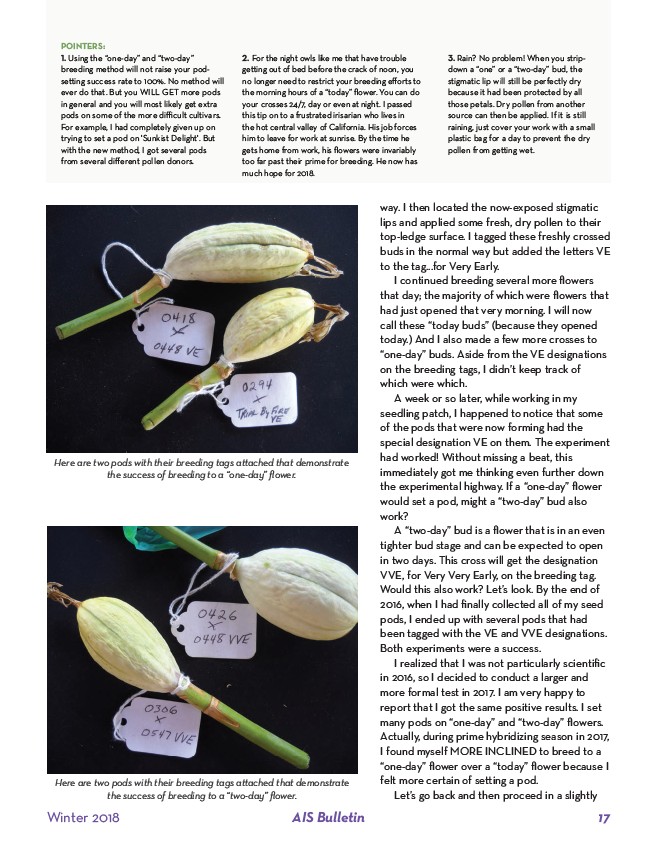
2. For the night owls like me that have trouble
getting out of bed before the crack of noon, you
no longer need to restrict your breeding efforts to
the morning hours of a “today” flower. You can do
your crosses 24/7, day or even at night. I passed
this tip on to a frustrated irisarian who lives in
the hot central valley of California. His job forces
him to leave for work at sunrise. By the time he
gets home from work, his flowers were invariably
too far past their prime for breeding. He now has
much hope for 2018.
3. Rain? No problem! When you stripdown
a “one” or a “two-day” bud, the
stigmatic lip will still be perfectly dry
because it had been protected by all
those petals. Dry pollen from another
source can then be applied. If it is still
raining, just cover your work with a small
plastic bag for a day to prevent the dry
pollen from getting wet.
way. I then located the now-exposed stigmatic
lips and applied some fresh, dry pollen to their
top-ledge surface. I tagged these freshly crossed
buds in the normal way but added the letters VE
to the tag...for Very Early.
I continued breeding several more flowers
that day; the majority of which were flowers that
had just opened that very morning. I will now
call these “today buds” (because they opened
today.) And I also made a few more crosses to
“one-day” buds. Aside from the VE designations
on the breeding tags, I didn’t keep track of
which were which.
A week or so later, while working in my
seedling patch, I happened to notice that some
of the pods that were now forming had the
special designation VE on them. The experiment
had worked! Without missing a beat, this
immediately got me thinking even further down
the experimental highway. If a “one-day” flower
would set a pod, might a “two-day” bud also
work?
A “two-day” bud is a flower that is in an even
tighter bud stage and can be expected to open
in two days. This cross will get the designation
VVE, for Very Very Early, on the breeding tag.
Would this also work? Let’s look. By the end of
2016, when I had finally collected all of my seed
pods, I ended up with several pods that had
been tagged with the VE and VVE designations.
Both experiments were a success.
I realized that I was not particularly scientific
in 2016, so I decided to conduct a larger and
more formal test in 2017. I am very happy to
report that I got the same positive results. I set
many pods on “one-day” and “two-day” flowers.
Actually, during prime hybridizing season in 2017,
I found myself MORE INCLINED to breed to a
“one-day” flower over a “today” flower because I
felt more certain of setting a pod.
Let’s go back and then proceed in a slightly
POINTERS:
1. Using the “one-day” and “two-day”
breeding method will not raise your podsetting
success rate to 100%. No method will
ever do that. But you WILL GET more pods
in general and you will most likely get extra
pods on some of the more difficult cultivars.
For example, I had completely given up on
trying to set a pod on 'Sunkist Delight'. But
with the new method, I got several pods
from several different pollen donors.
Here are two pods with their breeding tags attached that demonstrate
the success of breeding to a “one-day” flower.
Here are two pods with their breeding tags attached that demonstrate
the success of breeding to a “two-day” flower.
Winter 2018 AIS Bulletin 17